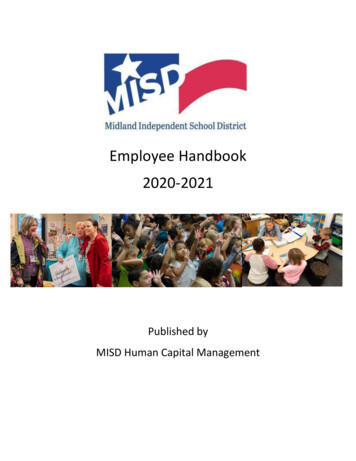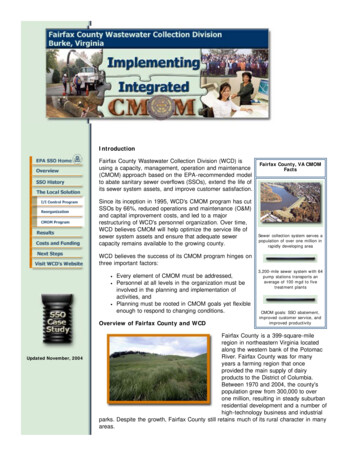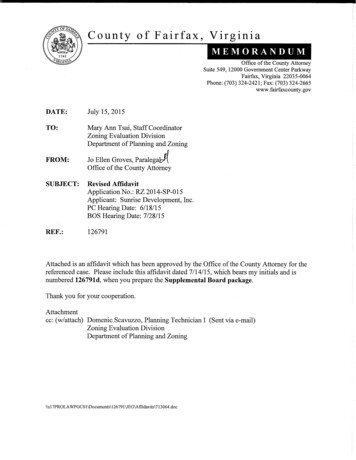
Transcription
Fairfax CountyEmployee Handbook1
2
Welcome from County Executive Bryan HillWelcome to Fairfax County! By almost anymeasure, this is a great place to work. Ourtalented, dedicated and innovative staff iscommitted to the ideals of public serviceand it is an honor for me to serve alongsideyou.Our county is recognized as one of the bestmanaged jurisdictions in the country andwe are one of just a few counties nationwidewith a Triple-A bond rating, underscoring our financial strengthand stewardship.To help you succeed in your career with Fairfax County, we providevaluable training and tools, including this guide. Whether youare a new or veteran employee, you can find the answers to yourquestions regarding your employment with the county. Please takesome time to review the guide and become familiar with FairfaxCounty’s code of ethics and standards of conduct, as well as yourbenefits, rights and responsibilities as an employee.The strategic planning process we are engaged in will help ensurethat Fairfax County continues to deliver excellent service whileguiding change that helps us move forward. Underpinning all ofour work, including our strategic plan, are the principles of OneFairfax, which ensures that we consider social and racial equitywhen making policies as we deliver programs and services to thegreat residents of Fairfax County.Congratulations on your new position and I wish you every successin your career with Fairfax County.3
IntroductionWelcome to Fairfax County Government! We are excited you havechosen to join our organization and hope you will enjoy a long andsuccessful career with us. As you become familiar with our cultureand mission, we hope you will take advantage of our programsand training to enhance your career while serving the residents ofFairfax County. You are joining an organization with a reputationfor outstanding leadership, expertise and service. Our employees usetheir creativity and talent to meet demands, and offer outstandingservices. With your active involvement, creativity, and support, youragency will continue to achieve its goals. We sincerely hope you willtake pride in being an important part of Fairfax County’s success.We wouldn’t be Human Resources if we didn’t tell you thishandbook is intended to serve as a source of information aboutyour employment with Fairfax County and is presented solely forinformational purposes and is not a contract between Fairfax Countyand any of its employees. The employee handbook supersedes allprior policies or procedures as to the subjects addressed in thishandbook. If you are provided information that conflicts with thishandbook, the most up to date provisions of the handbook and/ orappropriate regulation or procedure will govern. While every efforthas been made to ensure that the information in this handbookaccurately reflects the pertinent laws, ordinances, regulations andpolicies as of the time of publication, provisions may be changed orcancelled at any time. Such changes, amendments or cancellationsmay be done with or without notice. Employees are responsible forstaying informed of changes in those laws, ordinances, regulations,and policies. Your department may have specific workplace policiesand procedures that govern your employment.If you need further information or advice on the matters covered inthis handbook, please contact your supervisor, department head, orthe Department of Human Resources.Cathy Spage, Director, Department of Human ResourcesJune 20194
County HistoryOne of the first people to record life in what is now Fairfax Countywas English explorer Captain John Smith. In 1608, he journeyedup the Potomac River as far as present-day Arlington County. In1649, King Charles II of England granted all the land between theRappahannock and Potomac rivers to a group of seven Englishmen.Eventually, in 1719, this land came into the possession of Thomas,sixth Lord Fairfax, after whom Fairfax County was named.By 1732, there were attempts to form the land into a county,but it was not until 1741 that the Virginia Assembly, meeting inWilliamsburg, created Fairfax County.In 2017, Fairfax County celebrated its 275th anniversary with aseries of commemorative events, videos and a visit from LordNicholas Fairfax, a direct descendent of Fairfax County’s namesake.A complete demographic view of the county is available at general-overview.GovernanceFairfax County operates under the urban county executive formof government. The powers of government are vested in an electednine-member Board of Supervisors, plus a chairman elected at-large.Board members are elected for four-year terms. There are no termlimits. The Board appoints the county executive, who is theadministrative head of county government and is responsible for theadministration of all county affairs under the Board’s authority.The County Executive’s Office focuses on strategic planning,excellence in public service, fostering partnerships with ourresidents and community leaders, preparing the annual budget andexecuting all resolutions and orders of the Board.For more information including upcoming meetings, reports andboard priorities, go to www.fairfaxcounty.gov/boardofsupervisors/5
Code of Ethics and Standards of ConductIt is the policy of Fairfax County Government to ensure that allemployees observe the Code of Ethics and the Standards of Conductand that all department heads and supervisors treat and disciplineemployees under their respective jurisdictions in a fair and equitablemanner. Employees who feel they have not been so treated have aright to present their grievances following the procedures outlinedin Chapter 17 of the Fairfax County Personnel Regulations: uments/hr/chap17.pdfCode of EthicsFairfax County’s Code of Ethics is intended to inspire superiorconduct, sensitivity and sound judgment. The code is intended tocomplement, not replace, professional codes of ethics. Employees areobligated to respect, honor and uphold the constitutions, laws andlegal regulations, policies and procedures of the U.S., Virginia andFairfax County. The code is supported by six core principles: Honesty: Be truthful in all endeavors; be honest and forthright witheach other and the general public. Public Service: Ensure all actions taken and decisions made are inthe best interest of the public and enrich and protect quality of life. Respect: Treat all individuals with dignity; be fair and impartial;affirm the value of diversity in the workplace and in FairfaxCounty; appreciate the uniqueness of each individual; create a workenvironment that enables all individuals to perform to the best oftheir abilities. Responsibility: Take responsibility for actions; worka full day; conduct all workplace actions with impartiality andfairness; report concerns in the workplace, including violationsof laws, policies and procedures; seek clarification when in doubt;ensure that all decisions are unbiased. Stewardship: Exercise financial discipline with assets andresources; make accurate, clear and timely disclosures to the public;maintain accurate and complete records; demonstrate commitmentto protecting entrusted resources. Trust: Build regard for one another through teamwork and opencommunication; develop confidence with the public by fulfillingcommitments and delivering on promises.6
Standards of ConductAll employees, regardless of grade, title or length of countyservice, are expected to adhere to the following Standards ofConduct. Violation of the Standards of Conduct is grounds fordisciplinary action up to and including dismissal.Leave and AttendanceEmployees are expected to: Comply with rules and regulations governing hours of work,absences, use of leave.Employees are prohibited from: Failing to report to work as scheduled without proper notice tosupervisor. Leaving work without permission. Arriving late for work on a consistent basis.Personal Behavior and ConductEmployees are expected to: Demonstrate professionalism and support the county’s commitmentto excellent customer service at all times. Exercise courtesy, respect and tact when dealing with fellowemployees and the public regardless of age, race, color, religion, sex,creed, national origin, marital status, disability, sexual orientation,genetic information, union or political affiliation, veterans’ status,disabled veterans’ status or any other factor unrelated to the impartialconduct of county business. Comply with a proper order of an authorized supervisor.Employees are prohibited from: Harassing employees, county vendors or members of the publicon the basis of race, color, religion, sex, sexual orientation, nationalorigin, age, marital status, disability, genetic information or any othercharacteristic now or hereafter protected by federal, state or countylaw. The prohibition includes, but is not limited to, sexual harassment.7
Standards of Conduct (continued) Engaging in rude or unprofessional behavior or disorderlyconduct even if the behavior is not expressly forbidden byregulation or law. Engaging in bullying, as defined in Chapter 2 of the FairfaxCounty Personnel Regulations. Using racial, sexist or ethnic slurs or other language thatdisparages any person on the basis of age, race, color, religion, sex,national origin, marital status, disability, sexual orientation, creed,genetic information, union or political affiliation, veterans’ statusor disabled veterans’ status. Being convicted of a crime that is committed on the job or afelony in Virginia of such nature that the public or other employeesmay be endangered if the employee remains in his or her positionor of such nature that reasonably undermines the public trust inthe employee’s ability to perform his or her duties. Engaging in conduct on or off duty that violates federal or statelaw, county ordinances or policies when the violation is related tothe employee’s activity as a county employee or to county businessor when it undermines public trust in the county or the employee’sability to perform his or her duties. Manufacturing, distributing, possessing, using or being underthe influence of alcohol or illegal drugs while at work or on countypremises with the exception of attendance at events where alcoholis permitted during off-duty hours. Threatening, assaulting, intimidating or harassing anotheremployee or a member of the public. Using obscene language toward fellow employees, supervisors,subordinates and/or members of the public. Abusing supervisory authority through favoritism, harassment,discrimination or mistreatment of employees.8
Standards of Conduct (continued)Protection and Proper Use of County Data, Property, Funds andRecordsEmployees are expected to: Use public property, resources and funds in accordance withestablished procedures. Maintain confidentiality with regard to client or customerinformation in accordance with state and federal law, countyordinance and county policy. Maintain employee confidentiality by preventing the disclosureof personal information to any unauthorized party.Employees are prohibited from: Using county data, facilities, equipment, property or employeesfor other than officially approved activities, except as permittedunder county policy or procedure. Engaging in any action prohibited by county informationtechnology policy or procedure. Carelessly or willfully causing destruction of county property. Knowingly falsifying or conspiring to falsify any county recordor report whether paper or electronic, (e.g., resume, time andattendance reports, workers’ compensation claims, travel and/orexpense vouchers).DrivingEmployees are expected to: Operate all county vehicles in accordance with federal, state andlocal driving laws. Operate privately owned vehicles being used in the performanceof county business in accordance with state and local driving laws. Remain aware of status of operator’s license and report anysuspension or revocation of driving privileges to their supervisorimmediately if job duties require the operation of a vehicle forcounty business.9
Standards of Conduct (continued)Employees are prohibited from: Knowingly operating a vehicle on county business without a validoperator’s license. Possessing, using or being under the influence of alcohol, illegaldrugs or prescription drugs that might adversely affect one’s abilityto drive, while driving a county vehicle or while driving a personalvehicle on county business.SafetyEmployees are expected to: Promote a safe and healthy working environment by complyingwith all appropriate safety and health regulations. Promptly report safety and health hazards so that they can becorrected before injuries result. Dress in appropriate attire, uniform or safety equipment asspecified by the standards and work rules for the agency andposition. Immediately report workplace violence to your supervisor orappropriate authority.Employees are prohibited from: Bringing a gun, either concealed or displayed, to work or ontocounty premises, with the exception that employees of countyagencies may store a lawfully possessed firearm and ammunitionin a locked motor vehicle on county premises. This prohibitionshall apply to all employees, except those authorized to carry afirearm at work or onto county premises based on the natureof their work. Such employees may do so only if specificallyauthorized by their appointing authority. Bringing any weapon (except a gun as expressly permittedabove), either concealed or displayed, to work or onto countypremises, unless specifically authorized to do so by the appointingauthority. For the purposes of this standard of conduct, the term weapon10
Standards of Conduct (continued)includes instruments of combat or any object carried for thepurpose of inflicting or threatening bodily injury.Outside Employment/Conflict of Interest/Political ActivitiesEmployees are expected to: Disqualify themselves in any decision where a conflict of interestmay be presumed to exist. Obtain permission from their appointing authority prior toengaging in private business activity, employment or other activityoutside of work that conflicts or interferes with full discharge oftheir official duties or the work they perform as a county employee.Employees are prohibited from: Accepting anything of value for performing or refraining fromperforming, an official job-related act or accepting anything ofvalue in order to assist another person in obtaining a county job,promotion or contract. Using information obtained in connection with countyemployment in order to obtain financial gain for the employee orothers. Accepting anything that might tend to influence the manner ofperformance of county employment or that might be intended toinfluence the manner in which an employee performs his or her job. Having a personal interest in any contract with the county. Participating in matters related to their employment in whichthe interests of the county employee or the interests of the countyemployee’s family members or business associates, might beaffected. Engaging in political activities, as defined in state law and countyordinance, while on duty, in uniform or on the premises of theiremployment with the county, except when engaging in thoseactivities is permitted by County Code § 3-1-19. Using their official authority to coerce or attempt to coerce a11
Standards ofElelementsConduct (continued)Performancesubordinate employee to pay, lend or contribute anything of valueto a political party, candidate or campaign or to discriminate againstany employee or applicant for employment because of that person’spolitical affiliations or participation in permitted political activitiesor failure to participate in political activities, except when theaffiliation or activity may be established by law as disqualification foremployment. Discriminating in the provision of public services, including, butnot limited to, firefighting, emergency medical or law enforcementservices or responding to requests for such services, on the basisof the political affiliation or political activities of the person ororganization for which such services are provided or requested. Suggesting or implying that the county has officially endorsed apolitical party, candidate or campaign.Each employee will: Observe the Code of Ethics, Standards of Conduct and otherworkplace rules. Conduct him/herself, both on and off the job, in a mannerwhich will reflect credit on the county government and respectivedepartments.Department heads and supervisors will: Inform employees of rules governing conduct and discipline as wellas other workplace rules and special requirements. Treat employees in a fair and equitable manner. Investigate apparent employee offenses, by following the county’spolicy on harassment, discrimination, and retaliation; (Search“OHREP” on FairfaxNet.) Administer appropriate disciplinary action when warranted and asdescribed in Chapter 16 of the Fairfax County PersonnelRegulations: uments/hr/chap16.pdf. Consult with the HR Director or designees if necessary wheredisciplinary action involving loss of pay is contemplated.12
Employment StatusCounty employment is divided into competitive and non-competitiveservice. Competitive positions include those filled in accordance withmerit principles outlined in the Fairfax County Personnel Regulationsand are afforded specific rights, responsibilities and protections.Employees in non-merit positions (generally including part-timeand political appointees) are only entitled to such rights and benefitsspecifically provided for in the Code of Virginia, the County Code,Fairfax County Personnel Regulations, an appointment resolutionpassed by the Board of Supervisors or procedural directives such asProcedural Memorandum 11-01: Exempt Service, issued by theCounty Executive. (Search “exempt service” on FairfaxNet.)Probationary PeriodUpon initial appointment to a merit position within FairfaxCounty Government, you must successfully complete a 12-monthprobationary period. This provides the opportunity for you toevaluate your job suitability or fit and for your supervisor to assessyour performance. Police officers, deputy sheriffs, animal protectionpolice officers, public safety communicators and firefighters begintheir probationary periods after successfully completing the trainingacademies. The department head may terminate an employee’sappointment during this period if they are unable or unwilling toperform their duties satisfactorily. You have limited appeal rightsduring this probationary period.Performance ManagementPerformance management is designed to be a year-roundpartnership between you and your supervisor with continuouscommunication throughout the planning, coaching, reviewing andrewarding phases. Performance management considers “what” youaccomplish over the review period as well as “how” you go aboutaccomplishing your work. Each employee is evaluated on a set ofcountywide behaviors that apply to all county employees, regardlessof position. Additionally, employees are evaluated on competenciesrelated to duties performed in their job. Newly hired or promoted13
Performance Management (continued)employees are evaluated after six and 12 months in the newposition. Thereafter, unless you are promoted, performance reviewsare conducted annually and used to identify strengths as well asareas for improvement in your work.If you have questions regarding performance requirements,ask your supervisor for clarification. Additional performancemanagement information can be found by searching “DHRPerformance Management” on FairfaxNet.Performance Pay IncreasesIn years when performance pay increases are funded, employeesin their initial probationary period (hired prior to April 1) areeligible to receive the full performance pay increase granted tomerit staff. Initial appointees hired April 1 or later are not eligible toreceive performance pay increases until the next annual cycle. Thisdesignation does not apply to market rate adjustments (MRAs) andacross-the-board pay increases.All employees receiving performance-based increases are expectedto be performing satisfactorily, including initial probationary staff.Probationary employees, eligible for the performance increase basedon hire date, may be denied the increase if documentedperformance problems exist. Pay increases for employees who werepromoted during the review period will be calculated based on thehigher (promotional) salary. No prorating will be applied. Questionsmay be directed to your agency HR manager or payroll contact.MRAs, across-the-board increases and longevity increases are nottied to the performance management process. Merit performancepay increases will be granted based on where the employee’s currentsalary is within their pay range. Non-merit employees are notautomatically eligible to receive performance increases. Pay increasedecisions for non-merit employees are at the discretion of thedepartment head.14
Promotion PolicyA promotion is a selection to fill a position through the competitiveprocess in a class with a higher paygrade. It is the policy of FairfaxCounty Government to provide a career service for its employees,which encourages individual development and acquisition of skillsand experience. In the competitive service, individuals must gothrough a competitive process (i.e., competitive examining), which isopen to all qualified applicants. This process may consist of a writtentest, an evaluation of the individual’s education and experience,and/or an evaluation of other attributes necessary for successfulperformance in the position to be filled. Search “job applicationguidelines and tips” on www.fairfaxcounty.gov for more informationCompensationPay PlansPay plans are approved by the Board of Supervisors. Fairfax Countyhas seven pay plans for its employees and they are as follows: S (General County Employees) L (Lawyers in the County Attorney’s Office) E (Executive) C (Uniformed Sheriff) F (Uniformed Fire/Rescue) O (Uniformed Police) P (Public Safety Communicators, Animal Protection PoliceOfficers)The pay range for your position depends on the grade level for yourclassification. The grade level for every class of work in the county islisted on the Classification Plan for the appropriate year. Your payrollcontact can explain how to read the current Classification Plan andCompensation Plan.PaydaysPayday is every other Friday. The pay period covers the two-weekperiod that ends two weeks prior to payday. There are 26 pay periodsin most calendar years. To view the pay periods, search “Pay Period15
Compensation (continued)Reference Chart” on FairfaxNet. The length of time that elapsesbefore new employees receive their first pay depends on the daywithin the pay period that they begin work.Employees typically receive pay for their first two weeks on the jobfour weeks after their start date. The department payroll contactcan tell new employees when to expect their first pay.Direct DepositThe county provides electronic funds transfer (EFT) for directdeposit of your biweekly pay into your financial institution account.All new employees are required to participate in direct deposit.Employees can obtain a direct deposit authorization form fromtheir department payroll contact or on the HR Payroll FairfaxNetpage. (Find in the Employee Center dropdown on FairfaxNet.)Pay Structure FAQsQ: What components are included under the general countymerit employees’ pay structure?A: The plan design, when fully funded, includes: Market rate adjustment (MRA). Performance increase. Longevity increase for employees who reach 20 and 25 yearsof service, (paid in lieu of the performance increase).Q: What pay plans are affected by this pay structure?A: The pay structure governs pay for employees on the S payscale (General County, Civilian Public Safety) and L pay scale(Lawyers in the County Attorney’s Office). It does not applyto Uniformed Public Safety Employees. Pay scale S and Lemployees participating in the Deferred Retirement Option Planprogram are covered.Q: How are performance increase amounts determined?16
A: Merit performance pay increases are granted based onwhere the employee’s current salary is within their pay range.(Non-merit employees are not automatically eligible to receiveperformance increases. Increase decisions for non-meritemployees are at the discretion of the department head, followingestablished procedures for processing increases.)Q: What calculation is used to determine the employee’s currentpercent standing within their pay range?A: Calculation to be used: 100*(current hourly rate – minimumhourly) / (maximum hourly – minimum hourly).This will be rounded to the nearest tenth of a percent.Q: Does Employee Self-Service (ESS) in FOCUS provideemployees information about their pay range?A: Yes. The field titled “Percent in Pay Range” can be found inthe Organizational Assignment and Salary Data tab in ESS.Q: Does only merit service count toward the length of servicefor longevity increases? How is time calculated for those withbreaks in service or for reemployed annuitants? Do periods ofpart-time service impact the calculation?A: Longevity increases are calculated based on the employee’sleave accrual date, which represents continuous merit servicewith breaks in service of less than one year. Part-time meritservice does count. Service before retirement will not count forreemployed annuitants. Exempt/non-merit service does notcount.17
Pay Structure FAQs (continued)Q: Who is eligible to receive an MRA?A: All merit and non-merit employees will receive the MRAwhen funded. Employees participating in the DROP programare eligible to receive the MRA. (Note that while DROPparticipants are eligible to receive the MRA, the increasedoes not increase the salary basis used to calculate retirementpayments.)Q: In what order are increases applied?A: The MRA is applied, then the performance or longevityincrease.Q: When will MRA and step increases be applied?A: For most years, the MRA will be applied to all eligibleemployees in Pay Period 15. Step increases are given each payperiod based on the employee’s next increase date.General Information About the Longevity Increase andEmployee EligibilityQ: How large is the longevity increase and is it a lump sumbonus payment or an increase to base pay?A: The longevity increase is a four percent increase to theemployee’s base pay up to the maximum of the pay range.Q: What date is used to determine years of service for thelongevity increase?A: The leave accrual date is used to calculate years of service.This is the same date used to calculate years of service for publicsafety longevity increases and represents continuous years ofservice with less than a one year break in service. See youragency payroll contact or HR manager if you have questionsabout your leave accrual date.Q: When are longevity increases given to employees reaching 2018
Pay Structure FAQs continuedor 25 years of service?A: Longevity increases are given every July to all employeesreaching 20 or 25 years by June 30 of that year. Employeesreaching those milestones on July 1 or later will receive thelongevity increase the following fiscal year.Q: Once an employee reaches the maximum salary in theirpay range, will they continue to be eligible to receive MRAs,performance increases or longevity increases?A: Once an employee is at the maximum of their pay range,they will only receive the MRA, if funded, since it moves thepay range and the employee’s salary. Employees at the top oftheir pay range will not be eligible for performance or longevityincreases.Q: If a merit employee is eligible for a four percent longevityincrease, do they also receive a performance increase that sameyear?A: No. The longevity increase is in lieu of a performanceincrease.Q: If an employee has more than 25 years of service, whatlongevity increases can they expect?A: The longevity increase at 25 years of service is the finallongevity increase for eligible employees.Q: Will an employee get a longevity increase even if they did notpass their performance evaluation?A: Yes. Longevity increases are intended to recognize employeesfor their overall contributions across many years of service.Years When Pay Increases Cannot Be Fully FundedQ: Will employees get the MRA and performance increase (orlongevity) increase every year?19
Pay Structure FAQs continuedA: If funding is available and the employee passes theirperformance evaluation, the employee will receive both the MRAand a performance increase each year. However, if the employee isat maximum of their salary range, they will only receive the MRA.Q: If the plan cannot be fully funded, what is the priority forwhich increases are funded?A: The Board adopted guidelines to consider in years where fullfunding may not be possible. Adjustments would first be made tothe MRA, for all employees. If reductions must be made, the MRAwill be reduced from full to partial to no MRA funding, dependingon affordability. If merit performance increases and longevityincreases cannot be funded in full, but some funding is available,consideration will be given to an across-the-board increase to payranges and salaries for all employees (Public Safety and GeneralCounty).Work Hours/Time and AttendanceWorking HoursWorking hours depend on the type of job you are doing. Mostfull-time employees are scheduled to work 40 hours per week.Because of the nature of various department activities, schedulesfor workdays and lunch periods vary.Every employee is entitled to two 15-minute breaks during aneight-hour workday. In some departments, these breaks arecombined with a 30-minute unpaid lunch to permit an hour fora lunch break. Your supervisor will e
in Chapter 17 of the Fairfax County Personnel Regulations: www. . , not replace, professional codes of ethics. Employees are obligated to respect, honor and uphold the constitutions, laws and legal regulations, policies and procedures of the U.S., Virginia and Fairfax County. . Build regard for one another through teamwork and open










